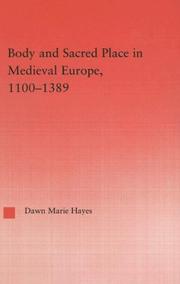| Listing 1 - 2 of 2 |
Sort by
|

ISBN: 0415988381 0203009061 9780203009062 9780415988384 9786610142088 6610142084 9781135860042 1135860041 9781135859992 113585999X 9781135860035 1135860033 9780415803526 0415803527 1280142081 Year: 2003 Volume: 18 Publisher: New York (N.Y.) : Routledge,
Abstract | Keywords | Export | Availability | Bookmark
 Loading...
Loading...Choose an application
- Reference Manager
- EndNote
- RefWorks (Direct export to RefWorks)
Body and Sacred Place in Medieval Europe investigates the medieval understanding of sacred place, arguing for the centrality of bodies and bodily metaphors to the establishment, function, use, and power of medieval churches. Questioning the traditional division of sacred and profane jurisdictions, this book identifies the need to consider non-devotional uses of churches in the Middle Ages. Dawn Marie Hayes examines idealized visions of medieval sacred places in contrast with the mundane and profane uses of these buildings. She argues that by the later Middle Ages-as loyalties were tor
History of Europe --- Christian church history --- anno 1200-1299 --- anno 1100-1199 --- anno 1300-1399 --- Sacred space --- Church buildings --- Human body --- Lieux sacrés --- Eglises --- Corps humain --- History --- Religious aspects --- Christianity --- Histoire --- Aspect religieux --- Christianisme --- Europe --- Church history --- Histoire religieuse --- Secular use --- History of doctrines --- Lieux sacrés --- Holy places --- Places, Sacred --- Sacred places --- Sacred sites --- Sacred spaces --- Sites, Sacred --- Space, Sacred --- Holy, The --- Religion and geography --- Body, Human --- Human beings --- Body image --- Human anatomy --- Human physiology --- Mind and body --- Churches --- Buildings --- Church facilities --- Church architecture --- Sacred space - Europe - History - To 1500 --- Church buildings - Secular use - Europe - History - To 1500 --- Human body - Religious aspects - Christianity - History of doctrines - Middle Ages, 600-1500 --- Thomas ep. Cantuariensis m. --- Chartres --- Notre-Dame (Chartres)
Book
ISBN: 9782503581408 2503581404 9782503581415 2503581412 Year: 2020 Publisher: Turnhout Brepols
Abstract | Keywords | Export | Availability | Bookmark
 Loading...
Loading...Choose an application
- Reference Manager
- EndNote
- RefWorks (Direct export to RefWorks)
This volume enhances our understanding of the various strategies used by early Norman rulers of Sicily and Southern Italy – but above all Roger II of Sicily - to establish authority and cultivate identity in the Mediterranean world. Roger II (c. 1095-1154), Sicily’s first king, was an anomaly for his time. An ambitious new ruler who lacked the distinguished lineage so prized by the nobility, and a leader of an extraordinarily diverse population on the fringes of Europe, he occupied a unique space in the continent’s charged political landscape. This interdisciplinary study examines the strategies that Roger used to legitimize his authority, including his relationships with contemporary rulers, the familial connections that he established through no less than three marriages, and his devotion to the Church and Saint Nicholas of Myra/Bari. Yet while Roger and his family made the most of their geographic and cultural contexts, it is convincingly argued here that they nonetheless retained a strong western focus, and that behind the diverse mélange of Norman Sicily were very occidental interests. Drawing together sources of political, social, and religious history from locations as disparate as Spain and the Byzantine Empire, as well as evidence from the magnificent churches and elaborate mosaics constructed during his reign, this volume offers a fascinating portrait of a figure whose rule was characterized both by great potential and devastating tragedy. Indeed, had Roger been able to accomplish his ambitious agenda, the history of the medieval Mediterranean world would have unfolded very differently.
Roger --- Sicily (Italy) --- History --- Kings and rulers --- Biography. --- Roger II --- Ruggero --- Ruggiero --- E-books
| Listing 1 - 2 of 2 |
Sort by
|

 Search
Search Feedback
Feedback About UniCat
About UniCat  Help
Help News
News